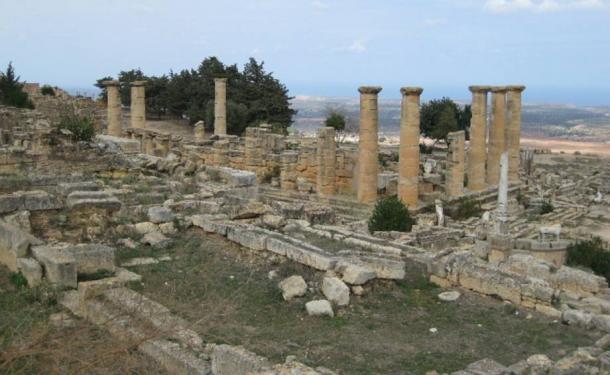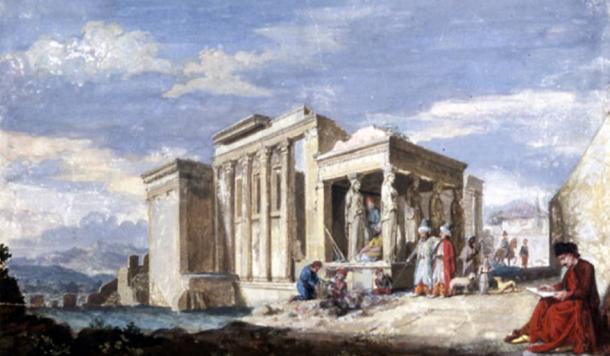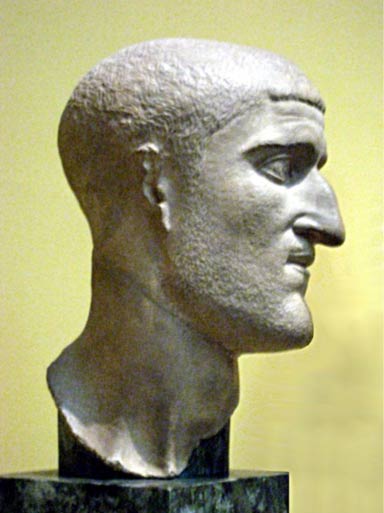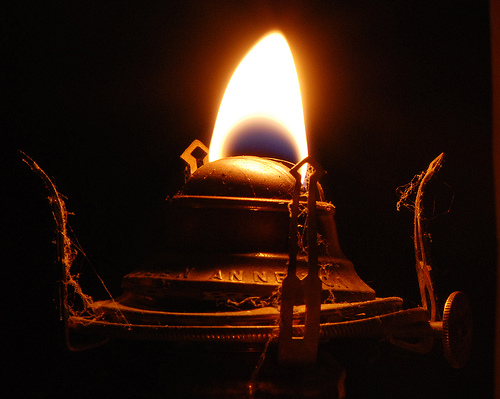Ever-Burning Lamps of the
Ancients.

Ever Burning Lamps.
Lamps that kept on burning
without using any fuel were discovered all over
the world during the Middle Ages. These lamps were
sealed into tombs, supposedly to ensure the
deceased had light to guide them on their way to
the afterlife. Some of these tombs were opened
years later, and the lamps were still burning.
Superstitious types became terrified of this phenomenon, destroying any ever-burning lamp they came across. People accused pagan priests of trickery. Others simply refused to believe that a lamp could burn for an indefinite period of time. The vast majority claimed that the Devil was to blame.
Speculation was also rife that Hebrew communities had discovered and preserved what today is known as electricity. According to the legend, a French rabbi named Jechiele possessed a lamp that could light up by itself, with no fuel or wick. Jechiele, according to this tale, invented a special button that would discharge an electric current to his metal door knocker. If someone touched the door knocker at the same time the rabbi touched the nail, the person would receive a shock and double over.
Superstitious types became terrified of this phenomenon, destroying any ever-burning lamp they came across. People accused pagan priests of trickery. Others simply refused to believe that a lamp could burn for an indefinite period of time. The vast majority claimed that the Devil was to blame.
Speculation was also rife that Hebrew communities had discovered and preserved what today is known as electricity. According to the legend, a French rabbi named Jechiele possessed a lamp that could light up by itself, with no fuel or wick. Jechiele, according to this tale, invented a special button that would discharge an electric current to his metal door knocker. If someone touched the door knocker at the same time the rabbi touched the nail, the person would receive a shock and double over.

Even with electricity being a
common thing nowadays, all who have tried to
replicate the ever-burning lamps have failed.
Therefore the question remains: How were these lamps
able to keep burning for hundreds of years without
fuel?
The
Ancient Mystery of the Ever Burning Lamps
15
DECEMBER, 2014 - 00:37 DHWTY

Picture
of an old lamp. Photo source: BigStockPhoto
Fire is only produced when
certain materials – a combustible material, an
oxidiser, and a source of heat, are present in the
right proportions. The absence of one or more of these
elements would extinguish a flame. It is believed,
however, that there are lamps whose flames have
continued burning for an exceptional amount of time
without human intervention. This phenomenon, which has
not been scientifically explained, is indeed a very
intriguing one. What are these so-called ever burning
lamps? Do they really exist?
Ever burning lamps have been recorded by writers from various parts of the world at different points of time. In the ancient world, for instance, the writer Plutarch mentions in his work ‘De Defectu Oraculorum’ that a lamp that burned over the door of the temple of Jupiter Ammon in Egypt. According to Plutarch, the priests of the temple claimed that the lamp stood in the open air, and neither wind nor rain put it out. Similar accounts are given for the altar of the Temple of Apollo Carneus, at Cyrene, and the great Temple of Aderbain, in Armenia.
Ever burning lamps have been recorded by writers from various parts of the world at different points of time. In the ancient world, for instance, the writer Plutarch mentions in his work ‘De Defectu Oraculorum’ that a lamp that burned over the door of the temple of Jupiter Ammon in Egypt. According to Plutarch, the priests of the temple claimed that the lamp stood in the open air, and neither wind nor rain put it out. Similar accounts are given for the altar of the Temple of Apollo Carneus, at Cyrene, and the great Temple of Aderbain, in Armenia.
Source: Ancient Origins

The Cyrene Temple of Apollo was said to once have an ever-burning lamp. Credit: megalithic.co.uk
Another Classical author,
Pausanias wrote about a gold lamp in the temple of
Minerva Polias in Athens. This lamp, which was built
by the scholar Callimachus, was said to have been
able to maintain a flame steadily for a year without
needing refuelling or having its wick trimmed. It
was also believed that Numa Pompilius, the legendary
second king of Rome, was able to communicate
directly with the gods, and that he created a light
that burned perpetually in a temple he had dedicated
to an elemental being. Some have even postulated
that Numa had knowledge of electricity, and that his
successor, Tullus Hostilius, was killed when his
attempt to draw electricity from lightning went
wrong.

Pausanias wrote about a gold lamp in the temple of Minerva Polias. Picture: The Erechtheion, the west end of the Temple of Minerva Polias and the Pandrosium on the Acropolis, Athens by James Stuart, 1750s-60s. Credit: grey pony / flickr

Pausanias wrote about a gold lamp in the temple of Minerva Polias. Picture: The Erechtheion, the west end of the Temple of Minerva Polias and the Pandrosium on the Acropolis, Athens by James Stuart, 1750s-60s. Credit: grey pony / flickr
Ever burning lamps have also
been described during the Late Antique and Medieval
periods. It is said that during the reign of the
Byzantine emperor Justinian, an ever burning lamp
was found by soldiers at either Edessa or Antioch.
According to the story, the lamp was discovered in a
niche over the city gate, and the inscriptions
suggest that the lamp has been burning for 500
years.
St. Augustine mentions an ever burning lamp in an Egyptian temple dedicated to Venus, and suggests that it was the work of the Devil. During the reign of Henry VIII (or the Early Medieval period, according to another source), an ever burning lamp was reported to have been found in England. As Henry separated from the Roman Catholic Church, and established the Church of England, he demanded the destruction of Catholic churches and communities should they refuse to be incorporated into his new church. It seems that even the dead were not spared, as the tomb of a wealthy man who died around the 4th century A.D. was opened. When the tomb was opened, a lamp that was still burning was found. Some have even claimed that this tomb belonged to Constantius Chlorus, the father of the emperor Constantine.
St. Augustine mentions an ever burning lamp in an Egyptian temple dedicated to Venus, and suggests that it was the work of the Devil. During the reign of Henry VIII (or the Early Medieval period, according to another source), an ever burning lamp was reported to have been found in England. As Henry separated from the Roman Catholic Church, and established the Church of England, he demanded the destruction of Catholic churches and communities should they refuse to be incorporated into his new church. It seems that even the dead were not spared, as the tomb of a wealthy man who died around the 4th century A.D. was opened. When the tomb was opened, a lamp that was still burning was found. Some have even claimed that this tomb belonged to Constantius Chlorus, the father of the emperor Constantine.

Emperor Constantius I Chlorus (Wikimedia Commons).
In India, the ancient Hindu
temple of Jwala Ji, located in the lower Himalayan
town of Jawalamukhi in Himachal Pradesh, has a
constantly burning blue flame that comes from the
rocks in various places within the temple, and is
said to have been constantly burning since the
beginning of its known history.
Although there is a surfeit of stories regarding ever burning lamps from various periods of time, it seems that there is a conspicuous lack of physical evidence for such objects. Furthermore, there is no known substance with such properties. Numerous explanations have been proposed to explain this mystery, ranging from the ‘work of the Devil’ to ‘alien gods’. Others, however, have attributed such inventions not to external forces, but to the genius of human beings. Could our ancient ancestors have held knowledge regarding a way to create a perpetual flame, which has become lost to the pages of history?
It is certainly possible, however, given the fact that there is no physical proof for such lamps, some are inclined to believe that the ever burning lamps are just mere legend. Nevertheless, be it the work of extra-terrestrials, or human sages, or simply non-existent, the ever burning lamps will probably continue to be a mystery for a long time to come.
By Ḏḥwty
Source: Ancient Origins
Although there is a surfeit of stories regarding ever burning lamps from various periods of time, it seems that there is a conspicuous lack of physical evidence for such objects. Furthermore, there is no known substance with such properties. Numerous explanations have been proposed to explain this mystery, ranging from the ‘work of the Devil’ to ‘alien gods’. Others, however, have attributed such inventions not to external forces, but to the genius of human beings. Could our ancient ancestors have held knowledge regarding a way to create a perpetual flame, which has become lost to the pages of history?
It is certainly possible, however, given the fact that there is no physical proof for such lamps, some are inclined to believe that the ever burning lamps are just mere legend. Nevertheless, be it the work of extra-terrestrials, or human sages, or simply non-existent, the ever burning lamps will probably continue to be a mystery for a long time to come.
By Ḏḥwty
Source: Ancient Origins
Mystery Solved:
Ancient Tomb Lamps Still Found Burning
April 28, 2015 by Kathy J. Forti
April 28, 2015 by Kathy J. Forti

How were the Ancients able to
produce lamps, which could burn without fuel, for
hundreds, and in some cases thousands of years? The
secret of the eternal flame was regarded as God’s
sole property, but the ancient Egyptians figured it
out. They believed their dead needed light to guide
them on their journey to the Underworld, so before a
tomb was sealed the custom was to place an eternal
burning lamp inside. Not only was it an offering to
the god of the dead but it was the belief that light
kept away evil spirits.
Based on ancient records these mysterious eternal burning lamps were discovered in tombs and temples all over the world going back even to the Middle Ages, where more than 170 medieval authors wrote about this strange phenomenon. It is unfortunate that so many of these lamps were destroyed by early day vandals and looters who feared they possessed supernatural powers.
The stories of these lamps are quite remarkable:
St. Augustine described an Egyptian temple, dedicated to the goddess Venus, which contained a lamp which could not be extinguished. He declared it to be the work of the devil.
In 527 A.D., at Edessa, Syria, during the reign of emperor Justinian, soldiers discovered an ever-burning lamp in a niche over a gateway, elaborately enclosed to protect it from the air. According to the inscription, it was lit in 27 A.D. The lamp had burned for 500 years before the soldiers who found it, destroyed it.
In 140, near Rome, a lamp was found burning in the tomb of Pallas, son of King Evander. The lamp, which had been alight for over 2,000ancientcavelamp-600x299 years, could not be extinguished by ordinary methods. It turned out that neither water nor blowing on the flame stopped it from burning. The only way to extinguish the remarkable flame was to drain off the strange liquid contained in the lamp bowl.
In about 1540, during the Papacy of Paul III a burning lamp was found in a tomb on the Appian Way at Rome. The tomb was believed to belong to Tulliola, the daughter of Cicero. She died in 44 B.C. The lamp that had burned in the sealed vault for 1,550 years was extinguished when exposed to the air.
When King Henry VIII broke away from the Catholic Church in 1534, he ordered dissolution of monasteries in Britain and many tombs were plundered. In Yorkshire, a burning lamp was discovered in a tomb of Constantius Chlorus, father of the Great Constantine. He died in 300 A.D. which means that the lamp had been burning for more than 1,200 years.
In his notes to St. Augustine, 1610, Ludovicus Vives writes about a lamp that was found in his father’s time, in 1580 A.D. According to the inscription, the lamp was burning for 1,500 years, however when it was touched it fell into pieces. Obviously, Ludovicus Vives did not share some of St. Augustine’s views. He considered perpetual lamps to be an invention of very wise and skilled men and not the devil.
For centuries the answer to the riddle of what type of renewable fuel the ancients used has remained a mystery. About a year ago, when I first became interested in this subject, I came across an obscure report of someone opening a tomb and finding strange “liquid silver drops” on the floor. It had an ever-burning lamp in it, but somehow it had broken. I immediately thought back to the thermometer I broke as a child and seeing the liquid mercury beads go scattering. My mother warned me not to touch them and immediately vacuumed them up before disposing of the bag. I was sure the “silver drops” in the tomb were mercury.
Mercury was the key tool of the early alchemist along with sulfur and salt. These were believed to be the Earth’s three principal substances, also called Body (Salt), Soul (Sulfur) and Spirit (Mercury). The ancient alchemists used them in combination to perform what often appeared as magic. Mercury has some interesting effects. It can be extremely volatile and has been coined the “Eagle.” Unless it is effectively contained and sealed, it rises into the air and is lost.
In 1675 a French astronomer named Jean-Felix Picard made a remarkable observation. He was carrying a mercury barometer, when he noticed that the empty-space glowed as the mercury jiggled. Many people tried to explain this phenomenon, among which an English scientist named Francis Hauksbee, who was the first to demonstrate a gas-discharge lamp in 1705, operated with static electricity. 100 years later, Vasily V. Petrov, a Russian self-taught electrical technician, described for the first time the phenomenon of the electrical arc, which led to different kinds of discharge light sources. One such type of high-intensity discharge lamp uses mercury-vapor.
Mercury-vapor_lamp-lamp_filter_PNr°0028How would such a mercury-vapor lamp work? A gas discharge lamp is a light source that generates light by creating an electrical discharge through ionized gas. In other words, ionized gas from the heated mercury builds up in the sealed tomb, creating a self-sustaining electrical charge that fuels the light. Mercury has thermal conductivity, gives off heat, and can act much like a fusion reactor under certain conditions. I’m no scientist, but you can find a lot about how mercury works by searching the Internet, and it adds up. Perhaps this mystery is no mystery at all and a modern-day alchemist (aka chemical engineer) can verify this.
It’s interesting to note it was often reported that when a tomb was opened, the light went out. This would make sense if built up gas in the tomb is released. This may also explain why so many tomb robbers and archeological workers reported feeling acutely ill after entering many of these tombs. They were being exposed to mercury vapor poisoning—an invisible and odorless enemy. Maybe the Ancients intended to place such a toxic and deadly curse on any who should disturb their final resting place. Somewhere down the line, they had to suspect something in the tombs was hazardous to one’s health. As a result, it was not uncommon for those opening a tomb to first drill two holes in the vault door, thereby allowing the gas (or evil spirits) to escape prior to entering.
As synchronicity would have it, a breaking news story occurred this week while I was writing this blog. Archeologists discovered large quantities of liquid mercury beneath the Pyramid of the Feathered Serpent, the third largest pyramid in the ancient ruined city of Teotihuacan in Mexico. They suspect there are tombs down there. Local researcher Sergio Gomez told reporters that it completely surprised them. They had no idea why the liquid mercury was present or what use the ancients might have had for it. However, Gomez does reveal that liquid mercury has been found at three other ancient sites. The mainstream archeological community hasn’t figured it out yet, even though the pieces aren’t too hard to piece together. Their explanation: “Mercury might have been used to symbolize an underground river. Mercury’s sleek look and reflectivity must have lent to its ritualistic use.”
I wouldn’t be a bit surprised if they found tomb lamps down there. Hopefully they will also find more answers to ancient art of alchemy.
If you like this article, please subscribe to my free weekly blog on this website. Thank you and have a wonderful day.
SOURCE: Trinfinity 8
Dr. Kathy Forti is a clinical psychologist, inventor of the Trinfinity8 technology, and author of the book, Fractals of God.
Fractals of God: A Psychologist's Near-Death Experience and Journeys into the Mystical by Dr Kathy Forti ~ AMAZON BOOKS
- Ancient Origins - The Ancient Mystery of the Ever Burning Lamps
- Dr. Kathy Forti - Mystery Solved: Ancient Tomb Lamps Still Found Burning
- Lloyd, E., 2014 - The Mystery Of Ancient Ever-Burning Lamps
- MacGowan, D., 2014 - Ever Burning Lamps
- Mystery of India, 2014 - Eternal Flames of Jwala Ji Temple
- Nexus Magazine - Ever Burning Lamps
- Sacred Texts - The Secret Teachings of all Ages
- Sacred Texts - Wonders of Antiquity. 2014
- Séguin, X., 2014 - Perpetual Lamps
- Spirit Archive - Initiates
of the Flame -
[PDF]
- Thurtle, E., 2014. 10 - Unsolved Mysteries From Ancient Times
- Westcott - Rosicrucian
Thoughts on the Ever-Burning Lamps of the
Ancients


Webpages © 2001-2015 Blue Knight Productions |
